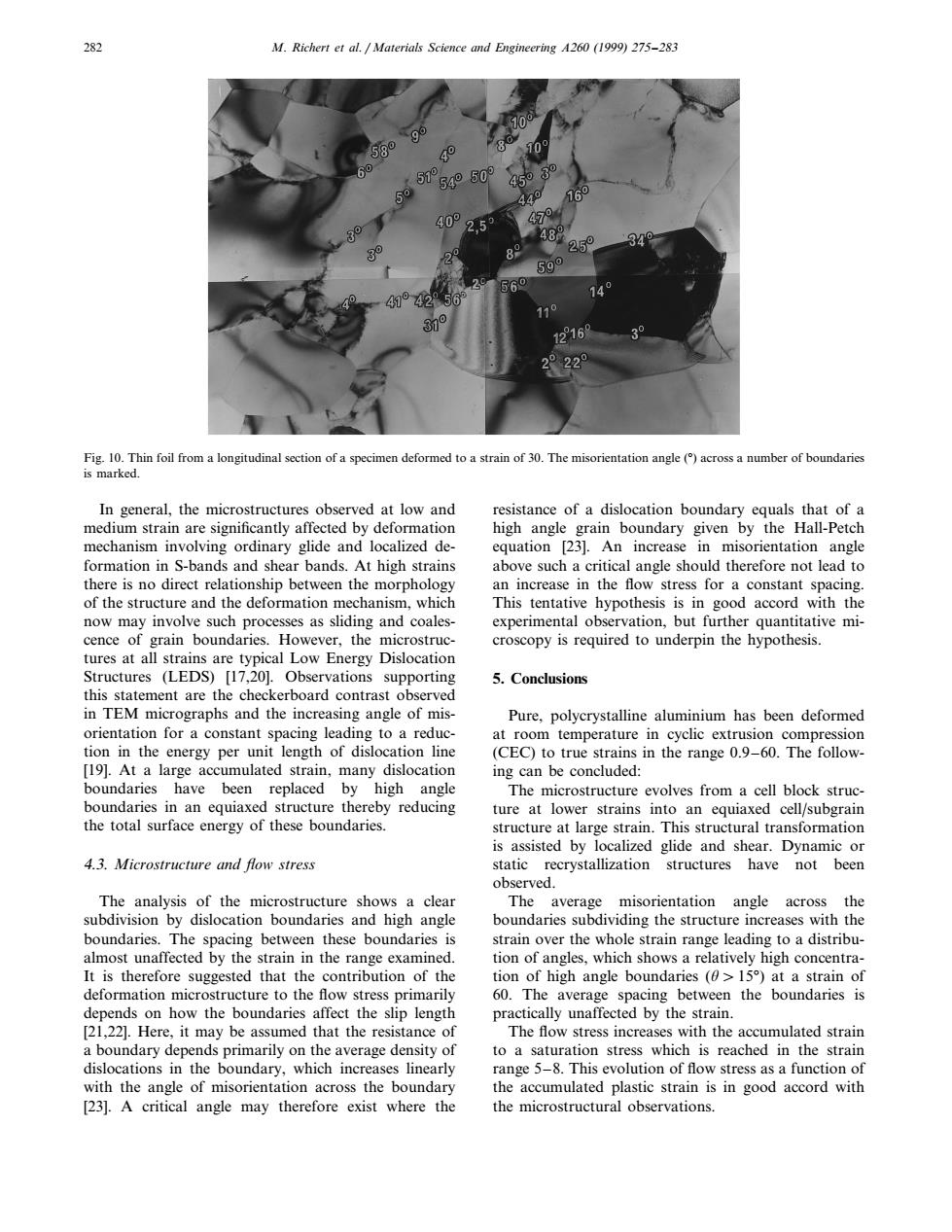正在加载图片...

282 M.Richert et al.Materials Science and Engineering A260 (1999)275-283 58° 5 54950 40° 2,59 o 350 5g0 414256 370 216 22 Fig.10.Thin foil from a longitudinal section of a specimen deformed to a strain of 30.The misorientation angle()across a number of boundaries is marked. In general,the microstructures observed at low and resistance of a dislocation boundary equals that of a medium strain are significantly affected by deformation high angle grain boundary given by the Hall-Petch mechanism involving ordinary glide and localized de- equation [23].An increase in misorientation angle formation in S-bands and shear bands.At high strains above such a critical angle should therefore not lead to there is no direct relationship between the morphology an increase in the flow stress for a constant spacing. of the structure and the deformation mechanism,which This tentative hypothesis is in good accord with the now may involve such processes as sliding and coales- experimental observation,but further quantitative mi- cence of grain boundaries.However,the microstruc- croscopy is required to underpin the hypothesis. tures at all strains are typical Low Energy Dislocation Structures (LEDS)[17,20].Observations supporting 5.Conclusions this statement are the checkerboard contrast observed in TEM micrographs and the increasing angle of mis- Pure,polycrystalline aluminium has been deformed orientation for a constant spacing leading to a reduc- at room temperature in cyclic extrusion compression tion in the energy per unit length of dislocation line (CEC)to true strains in the range 0.9-60.The follow- [19].At a large accumulated strain,many dislocation ing can be concluded: boundaries have been replaced by high angle The microstructure evolves from a cell block struc- boundaries in an equiaxed structure thereby reducing ture at lower strains into an equiaxed cell/subgrain the total surface energy of these boundaries. structure at large strain.This structural transformation is assisted by localized glide and shear.Dynamic or 4.3.Microstructure and flow stress static recrystallization structures have not been observed. The analysis of the microstructure shows a clear The average misorientation angle across the subdivision by dislocation boundaries and high angle boundaries subdividing the structure increases with the boundaries.The spacing between these boundaries is strain over the whole strain range leading to a distribu- almost unaffected by the strain in the range examined. tion of angles,which shows a relatively high concentra- It is therefore suggested that the contribution of the tion of high angle boundaries (>15)at a strain of deformation microstructure to the flow stress primarily 60.The average spacing between the boundaries is depends on how the boundaries affect the slip length practically unaffected by the strain. [21,22].Here,it may be assumed that the resistance of The flow stress increases with the accumulated strain a boundary depends primarily on the average density of to a saturation stress which is reached in the strain dislocations in the boundary,which increases linearly range 5-8.This evolution of flow stress as a function of with the angle of misorientation across the boundary the accumulated plastic strain is in good accord with [23].A critical angle may therefore exist where the the microstructural observations.282 M. Richert et al. / Materials Science and Engineering A260 (1999) 275–283 Fig. 10. Thin foil from a longitudinal section of a specimen deformed to a strain of 30. The misorientation angle (°) across a number of boundaries is marked. In general, the microstructures observed at low and medium strain are significantly affected by deformation mechanism involving ordinary glide and localized deformation in S-bands and shear bands. At high strains there is no direct relationship between the morphology of the structure and the deformation mechanism, which now may involve such processes as sliding and coalescence of grain boundaries. However, the microstructures at all strains are typical Low Energy Dislocation Structures (LEDS) [17,20]. Observations supporting this statement are the checkerboard contrast observed in TEM micrographs and the increasing angle of misorientation for a constant spacing leading to a reduction in the energy per unit length of dislocation line [19]. At a large accumulated strain, many dislocation boundaries have been replaced by high angle boundaries in an equiaxed structure thereby reducing the total surface energy of these boundaries. 4.3. Microstructure and flow stress The analysis of the microstructure shows a clear subdivision by dislocation boundaries and high angle boundaries. The spacing between these boundaries is almost unaffected by the strain in the range examined. It is therefore suggested that the contribution of the deformation microstructure to the flow stress primarily depends on how the boundaries affect the slip length [21,22]. Here, it may be assumed that the resistance of a boundary depends primarily on the average density of dislocations in the boundary, which increases linearly with the angle of misorientation across the boundary [23]. A critical angle may therefore exist where the resistance of a dislocation boundary equals that of a high angle grain boundary given by the Hall-Petch equation [23]. An increase in misorientation angle above such a critical angle should therefore not lead to an increase in the flow stress for a constant spacing. This tentative hypothesis is in good accord with the experimental observation, but further quantitative microscopy is required to underpin the hypothesis. 5. Conclusions Pure, polycrystalline aluminium has been deformed at room temperature in cyclic extrusion compression (CEC) to true strains in the range 0.9–60. The following can be concluded: The microstructure evolves from a cell block structure at lower strains into an equiaxed cell/subgrain structure at large strain. This structural transformation is assisted by localized glide and shear. Dynamic or static recrystallization structures have not been observed. The average misorientation angle across the boundaries subdividing the structure increases with the strain over the whole strain range leading to a distribution of angles, which shows a relatively high concentration of high angle boundaries (u\15°) at a strain of 60. The average spacing between the boundaries is practically unaffected by the strain. The flow stress increases with the accumulated strain to a saturation stress which is reached in the strain range 5–8. This evolution of flow stress as a function of the accumulated plastic strain is in good accord with the microstructural observations